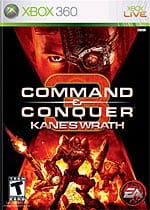Real Time Strategy Done Right
Sometimes good things come when you least expect them. The real time strategy genre rarely leaves its comfy PC home. This aversion to platform movement makes sense – translating a mouse and keyboard setup, which heavily relies on hotkeys, to a console controller is not an easy development task. Then there’s the performance side of the equation. PC RTS games usually have steep system requirements, keeping the number of early adopters at a very modest level. So, when you account for those aforementioned development hurdles, the odds are stacked against a console RTS port. That’s why Command & Conquer 3: Kane’s Wrath is so surprising – it manages to bring the strategy experience from the desktop to the living room in a completely accessible manner.
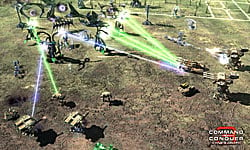
The colon in the game’s title should be the dead giveaway – Kane’s Wrath is an expansion. Unlike the PC version, this one does not require you to own the first title (Command & Conquer 3: Tiberium Wars). From a content standpoint, there are two differences between the PC and 360 versions. On the PC, Kane’s Wrath shipped with a Risk-like mode called Global Conquest. This mode utilized a world map and swapped out real time strategy for a turn-based system. That has been stripped out of the 360 version, but in its place the developers put a new mode entitled Kane’s Challenge. Made up entirely of skirmishes, Kane’s Challenge works in a ladder-like progression and allows you to play with the game’s three main factions (the Nod, GDI, and Scrin) and their respective three sub-factions. The ladder concept works well – it slowly eases you into learning the subtleties of each group.
Since Kane’s Wrath features a unique approach to console RTS controls, players should spend time in Boot Camp (essentially a tutorial mode). Here you’ll get your first taste of gameplay basics like base building and unit selection. However, the key is how you do these things. Far from being awkward, the control setup takes very little time to acclimate to and feels like second-nature after only an hour of gameplay. Almost everything is done with the A button and right trigger. You can do things like hold down A to select a group of units and double tap A to make a group attack move (meaning they’ll head toward a waypoint and attack any enemies along the way). Holding down the right trigger brings up a radial interface. From there, you can build structures, units, and access special powers. Most notable in the radial interface is the ability to assign units to numbered groups. This does a great job of replicating the hotkey function so vital in PC RTS games. Even the left trigger comes in handy. By squeezing it and pressing A you can automatically select every combat-ready unit in your field of view.
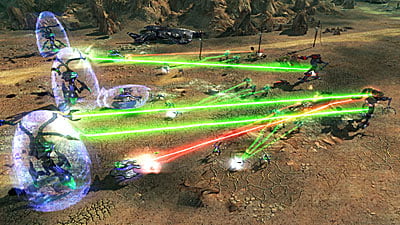
The 13 mission, single-player campaign takes place entirely from the perspective of Nod. It makes sense – this is Kane’s story of revenge against the GDI, and throwing in the other two main factions as playable campaigns would feel like filler material. It hardly matters anyway – if you must play with the other factions, then Kane’s Challenge, Skirmish mode, and multiplayer are the way to go. Tying together the plot of these missions are the infamous, Command & Conquer, full-motion video cutscenes. These sequences have an almost Sci Fi Channel quality. This comes off as both good and bad – mainly on account of the particular actors. Natasha Henstridge seems uncomfortable in her generic “we need a female somewhere” role and delivers her lines in B-movie fashion, while Joseph D. Kucan (Kane) is so over-the-top in his delivery it comes off as laughably good.
Story aside, playing through the actual campaign is an enjoyable experience. The missions objectives stay varied enough, so every level isn’t simply a variation of “wipe out the other guy’s base.” You’ll have to rescue combatants, steal enemy technologies, and even embark on the occasional stealth mission. It’s here – in the campaign mode – where the game’s pluses and minuses start to stand out. However, the minuses are really more quirks than bad mechanics. For example, while Boot Camp properly prepares you for utilizing the game’s unique control set, it leaves out explaining the entire tech tree. This becomes apparent when you do an early mission and realize you don’t know how to construct base defenses; you can build them, you just have to search around the radial interface for them. Also, mission objectives have a habit of cropping up when you least expect them. During one mission, you have to capture a building. While you would think that would end the mission, it doesn’t. Afterward, you’re notified you have to escort a key character across the map. Even if you’ve wiped out the computer’s on-screen bases, it will still send units out of nowhere to attack this character, and if you don’t have a battle-ready force prepared for escort duty, you’re out of luck and have to start the mission all over. The game also seems to have a built-in unit cap that it never lays out, so sometimes when you build a certain type of unit, the production will stop – it’s the game’s way of telling you, “We’ve already got too many of that unit.” Whether it’s in there for performance reasons or balance issues is up for debate.
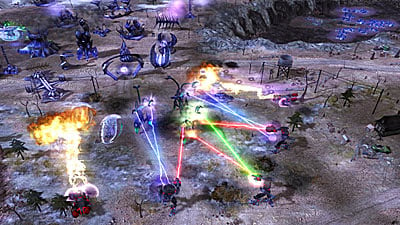
Any bad patches are overshadowed by Kane’s Wrath’s attention to unit specialization. Some RTS games are consumed with building a big force and sending it across the map, but in this game that just won’t do. It will do you good to learn the strengths and weaknesses of each unit. What’s your reward for that research? You can come up with some really tricky tactics.
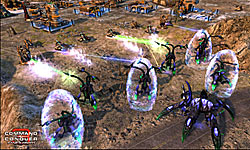
For example, Shadow Troopers have a stealth ability that allows them to sneak around the map. Okay, nothing fancy yet. If you build some Specters (heavy artillery) then it gets fun. Shadow Troopers can lay down a GPS-like beacon, which acts as targeting reticule for Specters. The great thing is the Specters can be anywhere on the map and hit the target. Using this team-up strategy, you can take out an entire base with just a team of Shadow Troopers and a few Specters.
Being an RTS, Kane’s Wrath has the typical audiovisual trappings of the genre. The graphics are detailed enough to make out particular units and structures (without having to zoom in) and the battles give a great sense of scale. Also, the framerate rarely stutters – it takes a ton of structures, units, and massive explosions to really stress the engine. Most RTS games suffer from repetitive audio and Kane’s Wrath is no exception. Units constantly blurt out their war cries and it doesn’t take long for this to get old. Hearing, “We’ve got rockets” over and over again just isn’t necessary. Thankfully, there’s a voice mute button.
The Campaign and Kane’s Challenge can soak up a good deal of time, but after a while you’ll venture over to the dedicated Skirmish mode. Not only can you select one of nine factions and a large assortment of maps, you can also play against the game’s scalable A.I. What makes the A.I. great is, aside from easy, medium, and hard difficulties, there are particular personalities the A.I. can adopt, ranging from Rusher (an early attacker) to Turtle (a purely defensive style) to Steamroller (favoring massive assaults); these tendencies will help prepare you for Xbox LIVE matches. Online, you can play with up to three people or swap them out for A.I. During review, there were initial problems with multiplayer. Since EA deals directly with the matches, the first few connection attempts were greeted with a message of “unable to connect to EA servers at this time.” But the problem seems to be fixed now and the few matches played exhibited no lag.
Kane’s Wrath is a great example that real time strategy can find a comfortable home on a console. With the added bonus of not needing the previous Command & Conquer installment, Kane’s Wrath comes as a very easy recommendation to RTS fans who may not have a gaming PC or simply want to try out their favorite genre on a different platform.
RATING OUT OF 5 RATING DESCRIPTION 4.0 Graphics
It’s an RTS, so detail is sacrificed for scale. Still, what’s there looks good and it all runs at a decent framerate. 4.5 Control
Wow, RTS controls that actually work well on a console. It’s still not as fast as a keyboard-mouse setup, but it feels pretty comfortable. 3.5 Music / Sound FX / Voice Acting
The score and in-game sound effects do a decent job. The repetitive unit cries and B-movie, in-game voice work are better off muted. 4.2 Play Value
The solid, single-player campaign, multi-tiered Kane’s Challenge, Skirmishes, and online play make for well-rounded gameplay options. 4.0 Overall Rating – Great
Not an average. See Rating legend above for a final score breakdown.
Game Features:
